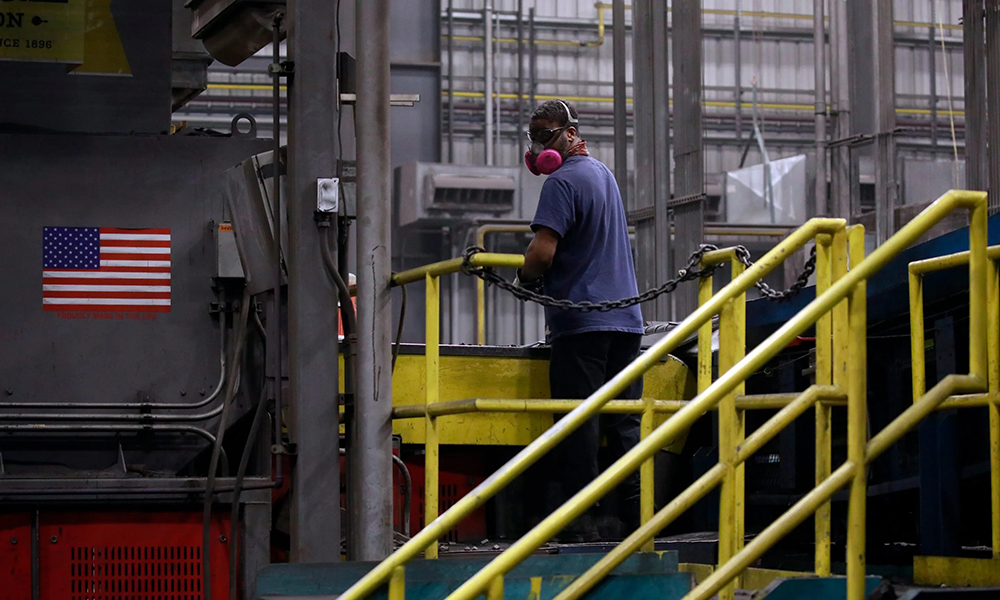
我们都看过小镇关闭最后一座工厂然后彻底沉沦的景象。小镇主干道两侧到处都是闲置的店铺,有能力的年轻人都会前往其他地区寻找更好的发展机会。虽然美国有一些社区确实是这幅景象,但还有一些社区打破了这种模式。
事实上,所谓制造业消失的说法被严重夸大。
工业就业岗位从2011年1月的1,160万个,增加到2021年10月的1,250万个,而且美国有数以百计的制造企业生产世界一流的产品,并实现了出色的财务业绩。这些企业组成了所谓的“钛经济”(指非面向消费者的工业品制造企业),他们的业绩可能对于美国实现迫切需要的可持续和包容性增长至关重要。
钛经济的存在是显而易见的,只是一直没有被发现。许多企业远离主要媒体市场,但他们生产的产品却非常重要,例如起重设备或石油再精炼等。这些企业的中位数年薪为63,000美元,而服务业的中位数年薪为30,000美元,而且这些企业的许多从业者并没有四年学位。
许多企业就在创始人的家乡。
预计有688家钛经济企业为上市公司,为私营企业的五分之一。他们在创造价值时,所考虑的是实体经济而不是金融。对这些企业开展的一系列全国性研究发现的最有趣的事情之一是,钛经济所覆盖的地区似乎通常是很适宜居住的城镇。
如果你想象出来的景象是一家古朴的工作室,雇佣了许多头发斑白的工人,周一还会供应松饼,那就重新想一想。约80%上市钛经济企业为中小盘股,其销售额从10亿美元到100亿美元不等,员工人数在2,000人至20,000人之间。380家最大的私营钛经济企业年收入总计约为2,500亿美元。
这些企业的一个特征是,他们擅长以创新驱动有机增长。因此,他们通常都是微观垂直领域的引领者。他们所在的专业领域有10至15家企业组成。由于市场较小,企业能非常细致地了解市场和客户。
以佛罗里达州新里奇港的Welbilt为例。该公司是工业厨房设备市场的主要企业,该市场的规模高达800亿美元。Welbilt很清楚,餐厅和其他大型厨房需要花费大量时间监控每台设备的温度。因此,经过三年的努力,该公司推出了一款创新技术,除了行业期刊以外,它并没有引起其他媒体关注。该公司开发了一种通用控制器和用户界面,可用于所有Welbilt设备。该技术能够提高生产效率、可靠性、质量和安全性,同时改善公司业绩。
这件事本身很有趣,但它的意义不止于此:钛经济企业成功所产生的积极影响,可能并不局限于他们自己的业绩。他们的强大意味着他们可以成为相关行业的中心,吸引人才和投资,然后吸引更多企业进入该领域,这就是我们所说的“大幅扩增循环”。
南卡罗莱纳州辛普森维尔的纺织业衰退之后,能吸引一家米其林(Michelin)工厂都感到非常激动。随后有汽车厂商到当地投资,然后各种关联行业落户该地,例如仓储和商业清洁等。
但这要归功于最初取得成功的希悦尔公司(Sealed Air)。这家钛经济企业成立于1955年,以生产气泡纸而著称。该公司成为当地社区的重要支柱,其成功也是向其他工业企业证明辛普森维尔的潜力的样板。政府也发挥了核心作用。当地政府营造了友好的营商环境,并与高中、大学和其他机构合作,建立和更新人才库。
美国钛经济所存在的一个问题是:我们需要更多钛经济企业。随着全世界机票、保险和人工成本大幅上涨,大力发展国内制造业有强大的经济理由。正如我们在新冠疫情期间所看到的那样,重要需求从国内得不到满足有许多负面影响。
然而,钛经济中心不会一蹴而就,他们需要经过逐步培养。在美国,公共和私人领域以及学术界的领导者大有可为。
钛经济企业的估值偏低,而且进入工业技术领域的风险资本不超过百分之一。公共部门对钛经济企业的支持也有限,尤其是与中国和德国等主要竞争对手相比。另外一点是观念上的挑战:对四年大学学位的看重,会严重低估制造业可以给人们带来的可能性。制造业可以为人们带来良好的发展机会。
人们可以为发展钛经济采取更多措施,并且迫在眉睫。经过良好的发展,美国可能出现越来越多钛经济中心,有望在每个地区形成创新和繁荣的良性循环。
发展钛经济没有必要采取强硬手段。投资者可以根据自己的标准评估工业技术。学校可以让学生了解制造业岗位,鼓励女生考虑进入这些行业。工会可以扩大学徒制。行业组织可以开发全国认可的、可转让的证书。州和国家政府可以考虑扶持发展工业4.0,尤其是在经济落后的区域。
钛经济是一个被隐藏的宝藏,它的存在颠覆了人们对于美国制造业的传统认知。继续扩大钛经济的优势,能够提高效率和韧性,提升企业的竞争力。(财富中文网)
本文作者阿苏托什·帕蒂为麦肯锡公司(McKinsey & Company)北美主理合伙人和《钛经济:工业技术如何让美国更美好、更快速、更强大》(The Titanium Economy: How Industrial Technology Can Create a Better, Faster, Stronger America)一书的作者之一。
译者:刘进龙
审校:汪皓
我们都看过小镇关闭最后一座工厂然后彻底沉沦的景象。小镇主干道两侧到处都是闲置的店铺,有能力的年轻人都会前往其他地区寻找更好的发展机会。虽然美国有一些社区确实是这幅景象,但还有一些社区打破了这种模式。
事实上,所谓制造业消失的说法被严重夸大。
工业就业岗位从2011年1月的1,160万个,增加到2021年10月的1,250万个,而且美国有数以百计的制造企业生产世界一流的产品,并实现了出色的财务业绩。这些企业组成了所谓的“钛经济”(指非面向消费者的工业品制造企业),他们的业绩可能对于美国实现迫切需要的可持续和包容性增长至关重要。
钛经济的存在是显而易见的,只是一直没有被发现。许多企业远离主要媒体市场,但他们生产的产品却非常重要,例如起重设备或石油再精炼等。这些企业的中位数年薪为63,000美元,而服务业的中位数年薪为30,000美元,而且这些企业的许多从业者并没有四年学位。
许多企业就在创始人的家乡。
预计有688家钛经济企业为上市公司,为私营企业的五分之一。他们在创造价值时,所考虑的是实体经济而不是金融。对这些企业开展的一系列全国性研究发现的最有趣的事情之一是,钛经济所覆盖的地区似乎通常是很适宜居住的城镇。
如果你想象出来的景象是一家古朴的工作室,雇佣了许多头发斑白的工人,周一还会供应松饼,那就重新想一想。约80%上市钛经济企业为中小盘股,其销售额从10亿美元到100亿美元不等,员工人数在2,000人至20,000人之间。380家最大的私营钛经济企业年收入总计约为2,500亿美元。
这些企业的一个特征是,他们擅长以创新驱动有机增长。因此,他们通常都是微观垂直领域的引领者。他们所在的专业领域有10至15家企业组成。由于市场较小,企业能非常细致地了解市场和客户。
以佛罗里达州新里奇港的Welbilt为例。该公司是工业厨房设备市场的主要企业,该市场的规模高达800亿美元。Welbilt很清楚,餐厅和其他大型厨房需要花费大量时间监控每台设备的温度。因此,经过三年的努力,该公司推出了一款创新技术,除了行业期刊以外,它并没有引起其他媒体关注。该公司开发了一种通用控制器和用户界面,可用于所有Welbilt设备。该技术能够提高生产效率、可靠性、质量和安全性,同时改善公司业绩。
这件事本身很有趣,但它的意义不止于此:钛经济企业成功所产生的积极影响,可能并不局限于他们自己的业绩。他们的强大意味着他们可以成为相关行业的中心,吸引人才和投资,然后吸引更多企业进入该领域,这就是我们所说的“大幅扩增循环”。
南卡罗莱纳州辛普森维尔的纺织业衰退之后,能吸引一家米其林(Michelin)工厂都感到非常激动。随后有汽车厂商到当地投资,然后各种关联行业落户该地,例如仓储和商业清洁等。
但这要归功于最初取得成功的希悦尔公司(Sealed Air)。这家钛经济企业成立于1955年,以生产气泡纸而著称。该公司成为当地社区的重要支柱,其成功也是向其他工业企业证明辛普森维尔的潜力的样板。政府也发挥了核心作用。当地政府营造了友好的营商环境,并与高中、大学和其他机构合作,建立和更新人才库。
美国钛经济所存在的一个问题是:我们需要更多钛经济企业。随着全世界机票、保险和人工成本大幅上涨,大力发展国内制造业有强大的经济理由。正如我们在新冠疫情期间所看到的那样,重要需求从国内得不到满足有许多负面影响。
然而,钛经济中心不会一蹴而就,他们需要经过逐步培养。在美国,公共和私人领域以及学术界的领导者大有可为。
钛经济企业的估值偏低,而且进入工业技术领域的风险资本不超过百分之一。公共部门对钛经济企业的支持也有限,尤其是与中国和德国等主要竞争对手相比。另外一点是观念上的挑战:对四年大学学位的看重,会严重低估制造业可以给人们带来的可能性。制造业可以为人们带来良好的发展机会。
人们可以为发展钛经济采取更多措施,并且迫在眉睫。经过良好的发展,美国可能出现越来越多钛经济中心,有望在每个地区形成创新和繁荣的良性循环。
发展钛经济没有必要采取强硬手段。投资者可以根据自己的标准评估工业技术。学校可以让学生了解制造业岗位,鼓励女生考虑进入这些行业。工会可以扩大学徒制。行业组织可以开发全国认可的、可转让的证书。州和国家政府可以考虑扶持发展工业4.0,尤其是在经济落后的区域。
钛经济是一个被隐藏的宝藏,它的存在颠覆了人们对于美国制造业的传统认知。继续扩大钛经济的优势,能够提高效率和韧性,提升企业的竞争力。(财富中文网)
本文作者阿苏托什·帕蒂为麦肯锡公司(McKinsey & Company)北美主理合伙人和《钛经济:工业技术如何让美国更美好、更快速、更强大》(The Titanium Economy: How Industrial Technology Can Create a Better, Faster, Stronger America)一书的作者之一。
译者:刘进龙
审校:汪皓
We’ve all seen pictures of small towns that lost their last factory and never recovered. Their Main Streets are pockmarked with vacant storefronts and the young leave as soon as they can in search of better opportunities. While there are communities across America that can be described this way, there are also many that break this mold.
Indeed, the death of manufacturing has been greatly exaggerated.
Industrial employment rose from 11.6 million jobs in January 2011 to 12.5 million in October 2021, and the United States is home to hundreds of manufacturers that deliver world-class products and excellent financial returns. Collectively, these companies make up the “Titanium Economy”–and their performance could be critical to driving the sustainable and inclusive growth our country needs.
The Titanium Economy is hidden in plain sight. Many of these companies are based far from major media markets, and they do important things like manufacturing lifting equipment or re-refining oil. Median annual pay is $63,000, compared to $30,000 for service jobs–and many of these jobs go to those without four-year degrees.
Many, too, are embedded in the hometowns of their founders and families.
An estimated 688 Titanium Economy companies are public–a fifth of the number of private ones. When they create value, it’s with Main Street, not just Wall Street, in mind. One of the most interesting things that stemmed from a set of nationwide research on these companies was that Titanium Economy hometowns often seem like great places to live.
If this conjures up images of a quaint workshop with a few grizzled workers and muffins on Monday, think again. About 80% of public Titanium Economy companies are small to mid-cap, with sales ranging from $1 billion to $10 billion and a headcount of 2,000 to 20,000 employees. The 380 largest privately-owned Titanium Economy companies have a combined annual revenue of about $250 billion.
One feature of this group is that they excel at innovation-driven organic growth. That is because they are often leading players in “micro-verticals”–clusters of ten to fifteen firms in specialty segments. Because the market is narrow, companies know it, and their customers, intimately.
Take New Port Richey, Florida-based Welbilt, a key player in the $80 billion industrial kitchen equipment market. Welbilt knew that restaurants and other big kitchens spent a ton of time monitoring the temperatures in each of their machines. So, after three years of effort, it created the kind of innovation that doesn’t make headlines outside the trade press: a common controller and user interface that could be used on all Welbilt equipment, improving productivity, reliability, quality, and safety–along with company performance.
All this is interesting in and of itself–but it is more than that: The success of Titanium Economy companies can spread far beyond their own bottom line. Their strength means that they can become hubs for related industries, bringing in talent and investment, which then attracts more companies, and so on: what we call the “Great Amplification Cycle.”
Simpsonville, South Carolina, was thrilled to attract a Michelin plant when its textile industry declined. Then carmakers followed, and then all kinds of adjacent industries, such as warehousing and commercial cleaning.
But Sealed Air was there first. This Titanium Economy company, founded in 1955, is best known for making bubble wrap. Its success has been a mainstay for the community throughout and was living proof for other industrial companies of the potential of Simpsonville. Government played a central role, too, by creating a hospitable business environment and working with high schools, universities, and other institutions to build and refresh the pool of talent.
There is one problem with America’s Titanium Economy: We need more of it. With freight, insurance, and labor costs rising around the world, there is a strong economic case for more domestic manufacturing. As COVID-19 showed, there are downsides to not being able to meet important needs on our own.
However, Titanium Economy hubs won’t just happen–they need to be nurtured. Across the U.S., leaders in the public and private sectors, and in academia, could be doing far more.
Titanium Economy companies are undervalued–and less than one percent of venture capital goes into industrial technology. Public sector support is limited too, especially when compared to major competitors like China and Germany. Another mindset challenge: the emphasis on four-year college degrees largely undersells the possibility of manufacturing to the people it would serve well.
More can be done–and it should be done with urgency. If properly nurtured, there could be more and more Titanium Economy hubs, potentially creating virtuous circles of innovation and prosperity in every region.
This effort doesn’t need to be heavy-handed. Investors could help themselves by evaluating industrial tech on its merits. Schools could open their students’ eyes to careers in manufacturing and encourage girls to consider these trades. Labor unions can expand apprenticeships. Trade groups could develop nationally recognized, transferable credentials. State and national governments could consider ways to support Industry 4.0, particularly in distressed regions.
The Titanium Economy is a hidden treasure that defies much of the conventional wisdom about U.S. manufacturing. Building on its strengths could foster greater efficiency and resilience and improve competitiveness.
Asutosh Padhi is McKinsey & Company’s North America managing partner and co-author of The Titanium Economy: How Industrial Technology Can Create a Better, Faster, Stronger America.






